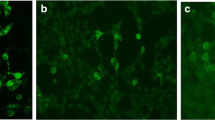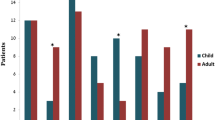Abstract
The long-term neuroimaging correlates of clinical recovery have not been described in anti-N-methyl-d-aspartate receptor (NMDAR) encephalitis. The aim of the study is to evaluate the long-term outcome of brain atrophy in anti-NMDAR encephalitis. Patients were two women (ages 17 and 33 years) with severe anti-NMDAR encephalitis resulting in decreased level of consciousness, autonomic instability, hypoventilation, and dyskinesias requiring continuous infusion of anesthetic agents for 6–7 months. Brain MRI and cerebral blood flow SPECT obtained at the time of maximal neurological disability were compared with similar studies obtained 5–7 years later. Both patients were hospitalized for 9–14 months and developed frontotemporal atrophy and hypoperfusion 7–12 months after symptom presentation. In both patients, cognitive functions gradually improved over the next 4–5 years. Comparative neuroimaging studies obtained 5–7 years after symptom presentation showed dramatic improvement of the atrophy and frontotemporal hypoperfusion. The severe and protracted deficits and the frontotemporal atrophy that occur in some patients with anti-NMDAR encephalitis are potentially reversible. This suggests that a functional rather than a structural neuronal damage underlies the pathogenesis of this disorder.


Similar content being viewed by others

References
Dalmau J, Tüzün E, Wu HY, Masjuan J, Rossi JE, Voloschin A, Baehring JM, Shimazaki H, Koide R, King D, Mason W, Sansing LH, Dichter MA, Rosenfeld MR, Lynch DR (2007) Paraneoplastic anti-N-methyl-d-aspartate receptor encephalitis associated with ovarian teratoma. Ann Neurol 61:25–36
Iizuka T, Sakai F, Ide T, Monzen T, Yoshii S, Iigaya M, Suzuki K, Lynch DR, Suzuki N, Hata T, Dalmau J (2008) Anti-NMDA receptor encephalitis in Japan: long-term outcome without tumor removal. Neurology 70:504–511
Dalmau J, Gleichman AJ, Hughes EG, Rossi JE, Peng X, Lai M, Dessain SK, Rosenfeld MR, Balice-Gordon R, Lynch DR (2008) Anti-NMDA-receptor encephalitis: case series and analysis of the effects of antibodies. Lancet Neurol 7:1091–1098
Iizuka T, Sakai F, Ide T, Miyakawa S, Sato M, Yoshii S (2007) Regional cerebral blood flow and cerebrovascular reactivity during chronic stage of stroke-like episodes in MELAS––implication of neurovascular cellular mechanism. J Neurol Sci 257:126–138
Geibprasert S, Gallucci M, Krings T (2009) Alcohol-induced changes in the brain as assessed by MRI and CT. Eur Radiol. doi:10.1007/s00330-009-1668-z
Gnjidić Z, Sajko T, Kudelić N, Malenica M, Vizner B, Vrkljan M, Hat J, Rumboldt Z (2008) Reversible “brain atrophy” in patients with Cushing’s disease. Coll Antropol 32:1165–1170
Wagner A, Greer P, Bailer UF, Frank GK, Henry SE, Putnam K, Meltzer CC, Ziolko SK, Hoge J, McConaha C, Kaye WH (2006) Normal brain tissue volumes after long-term recovery in anorexia and bulimia nervosa. Biol Psychiatry 59:291–293
de Lange FP, Koers A, Kalkman JS, Bleijenberg G, Hagoort P, van der Meer JW, Toni I (2008) Increase in prefrontal cortical volume following cognitive behavioural therapy in patients with chronic fatigue syndrome. Brain 131:2172–2180
Zivadinov R (2005) Steroids and brain atrophy in multiple sclerosis. J Neurol Sci 233:73–81
McLachlan RS (1987) Pseudoatrophy of the brain with valproic acid monotherapy. Can J Neurol Sci 14:294–296
Hughes EG, Peng X, Gleichman AJ, Lai M, Zhou L, Tsou R, Parsons TD, Lynch DR, Dalmau J, Balice-Gordon RJ (2010) Cellular and synaptic mechanisms of anti-NMDA receptor encephalitis. J Neurosci 30:5866–5875
Tüzün E, Zhou L, Baehring JM, Bannykh S, Rosenfeld MR, Dalmau J (2009) Evidence for antibody-mediated pathogenesis in anti-NMDAR encephalitis associated with ovarian teratoma. Acta Neuropathol. doi:10.1007/s00401-009-0582-4
Acknowledgments
We are extremely grateful to all participants for their contribution to this study, and acknowledge the efforts of all research staffs who worked on the clinical and neuroimaging data collection.
Conflict of interest statement
The authors have nothing to disclose regarding conflicts of interest or commercial relationships including grants, honoraria, speaker’s lists, significant ownership, or financial support from pharmaceutical or other companies.
Author information
Authors and Affiliations
Corresponding author
Rights and permissions
About this article
Cite this article
Iizuka, T., Yoshii, S., Kan, S. et al. Reversible brain atrophy in anti-NMDA receptor encephalitis: a long-term observational study. J Neurol 257, 1686–1691 (2010). https://doi.org/10.1007/s00415-010-5604-6
Received:
Accepted:
Published:
Issue Date:
DOI: https://doi.org/10.1007/s00415-010-5604-6



